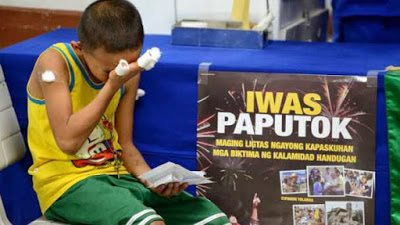
MANILA — The number of fireworks-related injuries (FWRI) reached 593 cases during the past 12 days, 393 cases or 39 percent lower than the 986 cases recorded from Dec. 21, 2013 to Jan. 2, 2014, Department of Health (DOH) statistics show.
Dr. Lyndon Lee-Suy, DOH spokesperson, said the figure was even 36 percent lower than the five-year average (2009-2013)of close to 600 cases.
Lee-Suy said the National Capital Region (NCR) topped the list of injuries after it recorded 318 cases from Dec. 21, 2014 to Jan. 2, 2015, followed by Region 1 with 64 cases.
The City of Manila alone recorded a total of 129 cases of FWRI.
In the said list of FWRI, 580 injuries were due to fireworks blasting, three for ingestion (swallowing), and 10 cases of stray bullet incidence.
About 81 percent or 471 of the injured were males, statistics show.
Some 155 children ages 10 years old and below were recorded to be victims also of injuries.
About 25 of the injuries required amputations while 103 with eye injuries due to the blast of firecrackers that hit portions of their eye/s.
Based on the data gathered, 317 cases of injuries were attributed to the use of illegal fireworks.
The small, banned and illegal firecracker “piccolo” remained to be the top cause of injuries.
On fireworks ingestion, the latest victim was a 32-year-old woman from Novaliches, Quezon City whose drinking glass was placed with watusi allegedly by her drinking mates.
About two children who are less than 10 years old were among the victims of stray-bullets.
A 13-year-old girl from Brgy. Batasan Hills in Quezon City was also hit by a stray bullet and now undergoing treatment at the East Avenue Medical Center.
Recording of injuries was being conducted by the National Epidemiology Center (NEC) that collates and verifies reports of 50 Sentinel hospitals (public and private) where most injured victims were being rush in the past years for comparative study.